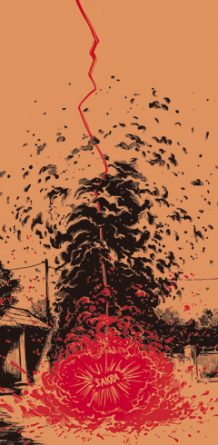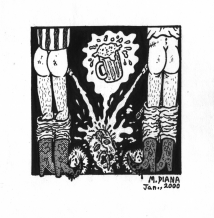| Umělec magazine 2010/2 >> Nostalgia for the NeverWas : Porno vs. The Impossible | List of all editions. | ||||||||||||
|
|||||||||||||
Nostalgia for the NeverWas : Porno vs. The ImpossibleUmělec magazine 2010/201.02.2010 Fausto Alzati | erotica | en cs de ru |
|||||||||||||
|
…to recognize ‘oneself’ as fully implicated in the world, frees us of the need to root politics in identification, vanguard parties, purity, and mothering.
Donna Haraway, The Cyborg Manifesto You are bound to find them, in the flea markets, subway stations and street corners of Mexico City: those red canvas-covered stands specializing in bootleg movies. Some sell DVD copies; others push films recorded on handheld video cameras at the nearby theater. Hundreds of insistent sellers traffic the seventh art on the streets of Mexico City—yet, out of the overwhelming sea of DVD sleeves, storylines and promised dramas, that one cover always emerges. Once spotted, it begs you to look again, or to look away. One movie invariably catches your eye; deviously, it prompts a double-take. The production of pornography trumps that of all other film genres, with annual revenues far exceeding those of any other facet of the entertainment industry, including sports. In Mexico City, vast numbers walk in and out of porn stands every day, poker-faced, hurriedly making their selections for after-work consumption. You might find yourself there, too, standing before a seemingly infinite array of covers, picking and choosing images to feed on later. Choices run the gamut, from big productions starring famous actresses, to amateur flicks, and even those shady affairs detailing what goes on behind the closed doors of Tenochtitlan’s various motel rooms. You might easily be surprised to find yourself staring at a picture of a woman lying post-fellatio, bathed in donkey sperm, or three women with penises decked out in latex in a hospital room. You can find teenagers, grannies, gay adolescents with piercing fetishes, Arabic lesbian bondage fantasies, transsexuals with razors, interracial anal sex, midgets and secretaries, necrophilia, bukake, gang-banging, squirting, tools and toys, sadomasochism, neo-Nazi gang bangs, manga-porn, urine and feces, and supermarket voyeurism. Look and you shall find; that is to say, you will be found. Personal 'immunity' from these images is a faulty idea. There is no external, impermeable place in life where the pornographic image, that fabric of our fantasy, cannot penetrate. That concept is an illusion. Even if you never bring what you see on screen into the bedroom, even if you are just watching—you are nevertheless a participant in the pornographic act. Watching, in other words, is not a passive activity. It’s easy to naïvely believe that a sense of skepticism and critical clarity will shield you from any effects that might come from consuming pornographic images. It is an infallible formula to continue being unaware that we are indeed unaware. Fantasies are unleashed, and many more are introjected. The sequences were filmed with a particular gaze in mind; hence, our gaze is already an intrinsic part of the scene we exchange gazes with. Indivisible. Thinking we are witty does not affect how vulnerable we are, it merely renders a blind spot. Turning away, to avoid watching these movies, doesn’t do the trick either; we are still looked at by others under the paradigms these images enact. Censorship does not cancel the forms of erotization (re)presented or simulated thereby. Interpellation. It is by means of these visions that we might analyze and deconstruct the narratives that shape the manifestations and textures of our fantasies. That which we desire —or believe we desire— and that which we reject are basic axioms interweaving the identities we assume, through which we interpret and act. No more, no less. Wherever we are, there we are. Porno is aesthetics, politics, and ethics. Theory dressed in lube. We cannot isolate, as if living in some absolute and independent manner. We are not permanent, but permeable. Since porn is such a difficult genre to define with clarity and certainty, its recognition often lacks any means of distinction other than the physical reactions it may incite in the spectator. Where are we if our bodies are felt-up by the images, outside or inside the screen? The film genre of most prolific production, involving how we look at each other and what we want from/with one another, deserves to be contemplated attentively; that we rid it of the façade of taboo, transgression and enigma that shelters it from proper reflection, so as to appreciate its relation with subjectivity. There is nowhere to turn where it is not there already, pulsating. Despite our investment in fascination, we can aspire to subjective creations which are not bound to mediation from these models of sense and meaning. The demand … Whosoever says “Don’t lie!” must before, also say, “Respond!” […] Between who commands and who obeys there is no inequality as radical as there is between who has the right to demand an answer and who is obliged to respond. I had a video camera, which could be plugged into the television set to see what had been recorded. It was possible to record while the camera was feeding into the TV set, showing on the screen whatever passed before the lens. Sure, what appeared onscreen was reduced to only that which occurred within the room; but I recall a particular effect that invited one’s gaze to absorption and a sense of estrangement surpassing that of any given representation. If the camera were pointed directly into the screen, an image of the television set did not appear; instead, a tunnel of flickering light emerged, the speed of its motion depending on the angle of the camera. It was as if the camera, in trying to look at its own gaze, was caught up in an endless deferral of its own gaze. Consciousness—or, rather, the registering of experience as such—exhibits a similar effect: in order for consciousness to be conscious of anything at all, it must be conscious of being conscious, in turn being conscious of being conscious of being conscious, and so on.1 It is not something one does on purpose; this continuous suspension and reflection is part of the structure of our experiences. Like the deferral of the camera in the face of its own gaze, desire—so to speak— also implies a continual elusiveness. It avoids being localized, or given any definite beginning or end. It is intangible, yet apparent. Desire evades definition (even this attempt); it moves between the irreparable cracks of our experience, always already appearing, always already inapprehensible. An orgasm, as such, is only ever experienced first hand; moreover, even as a first hand experience its qualities express a vertiginous display of ominous tonalities and textures: it cannot be pinpointed in either space or time. Despite this —or because of this—the camera tries to grasp it, desperately. In Hard Core. Power, Pleasure, and the “Frenzy of the Visible” (UC Press, 1989), author Linda Williams analyses the narratives to which the pornographic genre resorts in an attempt to make the invisible visible. The pornographic fixation with visibility, she explains (or so I understood), is rooted in modernity’s human urge for power through omniscience. Nothing should be allowed to escape the camera’s view. Everything must be predictable, contained, and under control. Even losing control must be under control. Yet, when it comes to human sexuality, something escapes... always. The female orgasm, as such, remains utterly untouched by the camera in all its attempts of tracing out a scientia sexualis. The camera seeks out an absolute confession by the body in its involuntary convulsions, in order to know that indeed something has happened. Something real. Likewise, if something 'involuntary' occurs, it suggests that whatever preceded or follows stems forth from a concrete, singular and definitive 'will'. Hence there is a recurrence of the images of ejaculating penises. Along with the spasm and the externalization of the interior (the semen), there is the promise of making the implicit explicit. It’s a sort of proof, or truth.2 Perhaps due to this, “frenzy of the visible,” the cinematic imaginary of popular culture began transposing feminine pleasure to the face by means of orality as exemplified in Deep Throat (Damiano, 1972). Since the face is considered more blatantly expressive, the intent is set on signifying feminine pleasure in this manner. When a penis ejaculates on screen, usually over the face a woman acting ecstatic to receive the foreign fluid on her mascara-loaded eyelashes, we can then be certain we have watched a porn movie, and it has alas, concluded. We have permission to be satisfied: something has just happened and there we were, as somebody. Though there are other strategies for representing the female orgasm (vaginal ejaculations, squirting, or even comic books whereby the insides of the vagina are drawn and surrounded by lines representing pleasure as electric currents), it remains that enjoyment as such, even that of a male, necessarily escapes representation. What is shown is an organ fulfilling a bodily function, but not an orgasm, since this always happens only as a firsthand experience in a constant and ongoing deference. There is no access to another’s jouissance. Regardless, as porno narratives evolve, deceiving a woman seems to have become, overtime, a necessary premise to signify pleasure: one must see how she is paid less than she bargained for, how something unexpected is done to her, how she is kicked off a boat into the water, or how something promised is denied —a green card for instance.3 She must be betrayed in return for the utter invisibility of her orgasm. Pain and deception can be seen and verified, even if her pleasure can’t. This relates to the realism fetish. Whether with webcams or digital cameras, this reality effect—a homemade video or one filmed without consent, preferably through the lens of a cell phone camera, the cheapo effect hereby considered a sign of reality—becomes an imperative fascination of its own accord.4 For example, in websites where videos of women urinating in public bathrooms are displayed, it has become a seal of authenticity to record the protagonists, in their “everyday activities.” “You see,” they seem to claim, “this is real, it is a real person, you have really seen her peeing.” Reality is an effect, a plug-in; one that mesmerizes, since it seems to offer a truth that can break away any creative responsibility regarding our subjectivity, by representing a definite reference point from which everything can be catalogued with absolute certainty. Not long ago, while surfing the spaces between idleness and anthropology, I came across a website where, by virtue of a sort of stethoscope-camera-dildo, one was able to look directly into the insides of a woman. This transparent, phallic instrument would enter the vagina, parting it open as if its wielder were engaging in a routine gynecological check-up. The pretense at stake was to witness a thing said to be “lost” after a woman’s first intercourse—her virginity. Such an insatiable insistence in localizing an origin, a purity, a limit or truth to verify and transgress. 5 What greater nostalgia than this? The hymen up-close, on screen. A fine membrane charged with connotations of purity, authenticity, totally fool-proof: now you see it, now you don’t. “Something has really happened here,” the video seems to say. “You can see it for yourself: the hymen has disappeared…See?” This storyline traces a nostalgic transit to the past of porno and in this retro impulse we find also a tendency of searching for a genesis—that verifiable something. In stags, those primitive films produced to be viewed usually by groups of men in university fraternities, the images were generally based on explorations of a woman’s body, as if playing doctor. The sequences often ended with blurry close-ups of the unknown darkness between the parted labia. In porn films from the early twentieth century, you find a recurrent theme now cast aside by realism: a sense of play. You see couples laughing, playing, having fun. The end of the exchange was often signified by a hug. Recently the aura of the scene is mystified, and a sort of cool humiliation parades as the necessary manifestation that allows proof of a will being violated by the appetite of another. The motion this brings about is almost ironic, for it first seeks out an ontological security only to later prove it is permeable; that is to say, that it indeed is not a solid base for being. It can be fractured, hence it exists. Porn narrative has not shifted much since the 1970s (a decade when porn films made it to the big screen; a time when porno theaters were still rather popular). A common narrative trait was the problem of pleasure—or pleasure as a problem—generally put forth and symbolized by a woman who has yet to find enough of something that will verify/define her pleasure. A retro tendency can also be found in amateur videos, which much in accord with 1970s porn, still show non-athletic and hairy bodies, but (regrettably) without the amazing funk soundtracks. Now looking at non-ideal bodies is also an ideal (of sorts), as exemplified by those who get off watching clandestine recordings of hotel rooms, where one can see one’s compatriots and neighbors in action. But at least in the 1970s you could still feel like a pervert for going to such a place as a porno theater. There still was the plus of that personal confrontation with another; you still had to attend a public space to watch motion picture porn. In the 1980s, home videos (the infamous 'beta videos') entered the market alongside the first porn movies to be directed by women. Changes in technology altered the storylines, alongside changes to the means of access to the films. In the 1970s, you still had to enter the public space to watch motion picture porn. Now, in the 1980s, couples or individuals could rent and watch videos in the privacy of the home. As a result, an overall shift from the grand narrative and large-scale production towards sub-categorization took place. An emphasis on specificity arose. Identity resurfaced as a central part of fantasy. As is characteristic of capitalism, identity came to be defined by the individual’s consumer preferences. The central question of the pornographic narrative came to be, “what are you into?” We can find nostalgia in the obsessive search for an impossible identity, through particularities of taste, obsessions, and fixations. Soon enough, the introduction of digital cameras, DVDs, microtechnology, cable TV, Pay-Per-View, the World Wide Web and piracy brought upon society a vast, abysmal plethora of obscenities. Digital technology allows you to focus with precision on hyper-specific images and sequences. Now the peculiar, accidental and bizarre can all be formally catalogued. Nothing suffices; the grotesque, violence, privacy, the strangest most-random acts, innocence (and it’s loss), special effects—even the cheapo, reality or retro effects—it’s not enough. Like a body dissected and cut up until it becomes so unrecognizable you can’t be sure what you were looking for in the first place, the question itself is lost. The subject and the object of inquiry are lost, or rather, deferred. With the distance the screen presupposed from the viewer, and the alleged anonymity of the web, it became the absolute masturbatory ideal. But something of this panoptic effect can be read in a more literal sense: we are the blindspot.6 Distance is almost credible, along with its offer of immunity. Easy target. Fascination obviates production; it takes us by surprise. The images are assumed as affective ideals, as deep truths of genuine and natural instincts. The clicks on the site become predictable. Mapped-out, calculated reactions… Visa or MasterCard? For all its halo of transgression and adventure into the forbidden, porn tends to be yet another manifestation of the normative, imposing tautological narrative onto that which defies and avoids definition. Aporia/desire. It leans towards normative transgression: a demand that the Law be completely unveiled, in order to Know. Let us recall that image conjured above: the tunnel of deferred luminosity that appears when the camera faces the screen, chasing its own gaze. Perhaps this is the only truly explicit image. At least, in it, what occurs is clear, naked: a continuous and luminous deference. Should we consider it quadruple-X rated? Intimacy Orgasm is the vortex of the body’s generalized laughter. In the introduction for Critique of Cynical Reason, Peter Sloterdijk suggests philosophy has been taken hostage by the strategies of power, turning into yet another gimmick in service of the equation, knowledge is power. But philosophy begins with love and journeys towards sincerity. Knowledge is not the goal, but an epiphany; the axis of which is love in the immediacy of everyday living. It is not a weapon in a chessboard battle; but rather, it is subjectivity itself mutating in order to touch and express its truth. Porn is loaded with affects, which it uproots and presents to the spectator, whose body reacts. The invitation has been delivered, and the flux of this exchange instigates us to imagine ourselves there—in specific ways. Ghosts are summoned in the imaginary, and flooded by the particularities of our fantasies, repetitions are unleashed. No more, no less. Just as when a word or gesture produces associations. Those associations are neither free nor above suspicion. They bear the precise markings of political power, of the established order in their narratives and in their preservation of identity and beliefs. The narratives that inhabit and haunt us are exposed, played-out, through our sexual activities and fantasies. It is like an object encased inside a museum, rather than a dynamic ritual. It is like an archaeological find that has been rendered completely devoid of its original meaning, having been reduced to merely an archaeological find. The porn that we “empathize” with now is a performance, an act, a job—something useful, a pedagogical product. Porn can be beautiful, monstrous, fun, strange, boring, or shocking, like any other image; regardless, its simulated permissiveness is profit-driven. Nudity is a disguise, the false maneuver of a pseudo-voyeuristic, panoptical intimacy. It is perhaps the faking itself that stimulates the viewer: “They’re faking it for me, for my gaze. Therefore I have power…acquisitive power…so I must exist.” The mis-en-scene is not established by the spectator’s gaze, it is the gaze that has become the object of tele-directed modifications. Distance becomes absolute through its very absence (associative fantasies set loose; no more, no less. Porno equals money). Our postmodern societies are burdened with the obligation to a normative enjoyment. The form and qualities of which are predesigned and calculated by the medical gaze/discourse—a gaze that promises to finally dissociate the observer from the observed. Nevertheless, when it comes to the erotic, something exceeds us; there is no access to the other’s enjoyment. The obligation to enjoy is the neoliberal face of anxiety, before a difference it seeks to cancel and neutralize; an attempt to silence the other, with the perforated logic of cynical empiricism. This is where the compulsion to speak about sex comes from, which is not only different than speaking from sexuality—but in a sense, the opposite. Speaking from sexuality assumes the inevitability of your own involvement. Speaking about sex is an attempt to disarm and measure from the perspective of a vigilante, high on the delirium of objectivity. It is a crumbling construction, trying to ward off immanence and space. It is the distinction between the vertigo of a kiss and the statistics of Masters & Johnson! Intimacy threatens utility, due to its spontaneity and the radiant openness it offers both towards the present and the other. It assumes how implied we are in living. Now comes to mind the variety of pills there are in the market, designed to regulate sexual performance or even to “alleviate” shyness, insomnia and anxiety. Now contact comes to mind…the radical difference of someone else. Now I want to close my eyes. Now a dream of the possible and the impossible. Now…a poem yet to be written…instead of an instruction manual scripted by gangsters and globalized by inertia. 1 Certain Buddhist text refers to this as “the self reflexive nature of awareness.” 2 External-internal, explicit-implicit, voluntary-involuntary are all mutually defined dichotomies, thereby mutually cancelled. Erasure. 3 In such cases as those of a promised green card, which is later denied, there is a current theme of economic advantage to exhibit control over the body. It is ironic how the deception of a woman is sought as a means of corroborating domination. If she fakes it for me, she has done so dutifully, as a response to an exercise of terror. Hence her faking is the visible proof. 4 I’d like to consider the ways in which this cheapo effect is used in political propaganda and advertising as such, to elude and appeal to constructed notion/image of the “popular” a concept fabricated whenever lack of resources is thought to equal reality and authenticity. 5 If an ontological-metaphysical law is verified and established definitively, then one can aspire to defy and overcome such a law. 6 This it to say, in the case of seeing without being seen, immersed in the flux of images, there is an oversight of the leverage the images hold on the gaze itself. 7 This reminds me of Claude Fell’s interview of Octavio Paz (Plural, no. 50, 1975), in which Paz described the figure of male authority in history and in Mexican mythology: “The caudillo is a hero, he is epic: He is above the law. He makes the law.” This means that if you are above the law, you are the law. Or, to quote the song “Jefe de jefes” (“Boss of bosses”) by Los Tigres del Norte: The Boss of Bosses is he whose word is law.
01.02.2010
Recommended articles
|
|||||||||||||
|
04.02.2020 10:17
Letošní 50. ročník Art Basel přilákal celkem 93 000 návštěvníků a sběratelů z 80 zemí světa. 290 prémiových galerií představilo umělecká díla od počátku 20. století až po současnost. Hlavní sektor přehlídky, tradičně v prvním patře výstavního prostoru, představil 232 předních galerií z celého světa nabízející umění nejvyšší kvality. Veletrh ukázal vzestupný trend prodeje prostřednictvím galerií jak soukromým sbírkám, tak i institucím. Kromě hlavního veletrhu stály za návštěvu i ty přidružené: Volta, Liste a Photo Basel, k tomu doprovodné programy a výstavy v místních institucích, které kvalitou daleko přesahují hranice města tj. Kunsthalle Basel, Kunstmuseum, Tinguely muzeum nebo Fondation Beyeler.
|








































 We Are Rising National Gallery For You! Go to Kyjov by Krásná Lípa no.37.
We Are Rising National Gallery For You! Go to Kyjov by Krásná Lípa no.37.
Comments
There are currently no comments.Add new comment